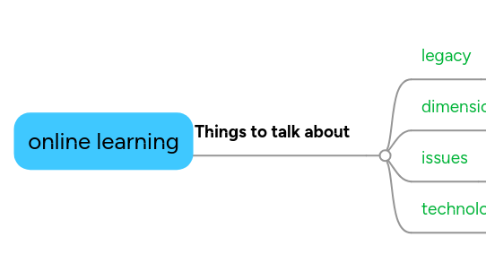
1. Things to talk about
1.1. legacy
1.1.1. correspondence schools
1.1.1.1. types
1.1.1.1.1. occupational education
1.1.1.1.2. certification
1.1.1.1.3. competency-based learning
1.1.1.2. practices
1.1.1.2.1. course as "package"
1.1.1.2.2. recruiting
1.1.1.2.3. failure profit
1.1.1.3. 1728, Caleb Phillips
1.1.2. Early attempts
1.1.2.1. Public TV
1.1.2.2. Kentucky Commonwealth U
1.1.2.3. Western Governors U
1.1.3. For-profit education
1.1.3.1. Phoenix
1.1.3.1.1. 443k students
1.1.3.2. Kaplan
1.1.4. Online higher ed today
1.1.4.1. 96% of US colleges and universities
1.1.4.2. engineering has relatively few online programse (Sloan)
1.1.4.3. 4.6 million students in 2008, up 17% from 2007, compared to 1.2% overall; 25% of all students take at least one course (Sloan)
1.1.5. Economies of scale?
1.2. dimensions
1.2.1. space
1.2.1.1. f2f
1.2.1.2. hybrid
1.2.1.3. online
1.2.2. time
1.2.2.1. synchronous
1.2.2.1.1. what needs to be done synchronously?
1.2.2.2. asynchronous
1.2.2.2.1. ditto asynch?
1.2.2.2.2. what effect does asynch have on discussion?
1.2.2.2.3. advantages, disadvantages?
1.2.2.3. multiple parallel discourse
1.3. issues
1.3.1. management
1.3.1.1. What are your roles as an online teacher (Xin and Feenburg, Wallace)?
1.3.1.2. How and how much should you be involved in (synch, asynch) discussion as instructor?
1.3.2. community
1.3.2.1. important for learning, satisfaction (Wallace)
1.3.2.2. "creepy treehouse"
1.3.3. interaction
1.3.3.1. How can we encourage participation?
1.3.3.2. How do you know if your students are participating?
1.3.4. coherence
1.3.4.1. What common ground elements of f2f communication are missing in online discourse (Xin and Feenburg 11-12)?
1.3.4.2. How do we move toward shared understanding if online discourse is more atomized and discrete than f2f exchanges?
1.3.4.3. What special dangers might arise in online discussion?
1.3.4.4. What special dangers might arise in online discussion?
1.3.4.4.1. How do we manage online silence ("communication anxiety"; Xin and Feenburg 11)?
1.3.4.4.2. Misbehavior?
1.3.4.4.3. Misunderstandings?
1.3.5. verisimilitude
1.3.5.1. Is there something unique about online learning?
1.3.5.1.1. "Most of the new wtools and practices employed in online education are electronically mediated versions of familiar pedagogical techniques" (Xin and Feenbrg 2)
1.3.5.2. Should our goal be to replicate the f2f experience?
1.3.5.3. equality
1.3.5.3.1. How can we meet the same course outcomes as a f2f?
1.3.5.3.2. Does "separate but equal" apply?
1.4. technologies
1.4.1. (How) is online learning determined by technology?
1.4.2. capabilities, limitations, implications
1.4.3. modes
1.4.3.1. text
1.4.3.2. voice
1.4.3.3. video
1.4.3.3.1. presenter
1.4.3.3.2. classroom
1.4.3.3.3. videoconference
1.4.3.4. "virtual reality"
1.4.3.4.1. 2L
1.4.3.5. game
1.4.3.6. sim
1.4.4. tools
1.4.4.1. web 2.0?
1.4.4.2. LMS/CMS
1.4.4.2.1. Blackboard
1.4.4.2.2. Moodle
1.4.4.3. open source
1.4.4.4. http://www.mindmeister.com/12213323
